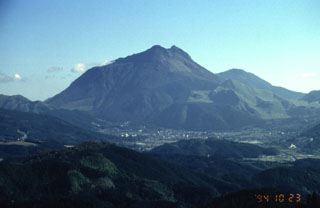Report on Yufu-Tsurumi (Japan) — 6 July-12 July 2022
Smithsonian Institution / US Geological Survey
Weekly Volcanic Activity Report, 6 July-12 July 2022
Managing Editor: Sally Sennert.
Please cite this report as:
Global Volcanism Program, 2022. Report on Yufu-Tsurumi (Japan) (Sennert, S, ed.). Weekly Volcanic Activity Report, 6 July-12 July 2022. Smithsonian Institution and US Geological Survey.
Yufu-Tsurumi
Japan
33.282°N, 131.39°E; summit elev. 1584 m
All times are local (unless otherwise noted)
JMA reported that during 0247-0500 on 8 July the seismic network at Yufu-Tsurumi recorded 57 volcanic earthquakes with hypocenters 1-4 km beneath Garandake, a small lava dome on the N flank of the larger Tsurumidake lava dome at the E end of the complex. The Alert Level was raised to 2 (on a scale of 1-5) at 0510 and the public was warned to stay 1 km away from Garandake. A total of 92 volcanic earthquakes were recorded by 1100 on 8 July; no additional events were detected through 11 July.
Geological Summary. A group of lava domes rises above the hot spring resort city of Beppu on Japan's Inland Sea, possibly within an ancient breached caldera. Two large lava domes, Tsurumidake and Yufudake (the highest at 1,584 m), are located at the east and west sides of the complex, respectively. Three smaller lava domes are on the N flank of Tsurumidake, including Garandake. The latest activity at both the andesitic-to-dacitic Tsurumi and Yufu groups postdates the 6,300-year-old Akahoya ash from Kikai volcano. Pyroclastic flows dominated during older eruptions, whereas lava domes and lava flows are most common in more recent eruptions. An eruption about 2,200 years ago from Yufudake began with collapse of the N flank that produced a debris avalanche and was followed by lava dome growth and associated pyroclastic flows. The most recent known eruption was from Tsurumi in 867 CE, when there was explosive activity from the summit area. The colorful hot spring pools and mudpots of Beppu along the coast are a noted thermal area.

